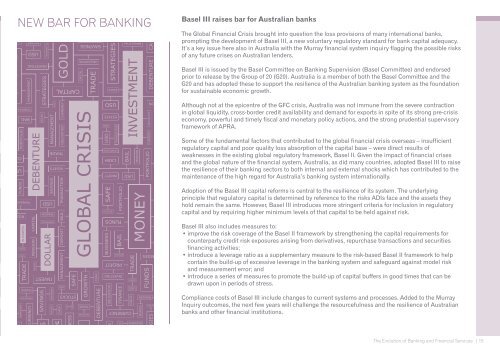EVOLUTION OF BANKING
Create successful ePaper yourself
Turn your PDF publications into a flip-book with our unique Google optimized e-Paper software.
New Bar for Banking<br />
Basel III raises bar for Australian banks<br />
The Global Financial Crisis brought into question the loss provisions of many international banks,<br />
prompting the development of Basel III, a new voluntary regulatory standard for bank capital adequacy.<br />
It’s a key issue here also in Australia with the Murray financial system inquiry flagging the possible risks<br />
of any future crises on Australian lenders.<br />
Basel III is issued by the Basel Committee on Banking Supervision (Basel Committee) and endorsed<br />
prior to release by the Group of 20 (G20). Australia is a member of both the Basel Committee and the<br />
G20 and has adopted these to support the resilience of the Australian banking system as the foundation<br />
for sustainable economic growth.<br />
Although not at the epicentre of the GFC crisis, Australia was not immune from the severe contraction<br />
in global liquidity, cross-border credit availability and demand for exports in spite of its strong pre-crisis<br />
economy, powerful and timely fiscal and monetary policy actions, and the strong prudential supervisory<br />
framework of APRA.<br />
Some of the fundamental factors that contributed to the global financial crisis overseas – insufficient<br />
regulatory capital and poor quality loss absorption of the capital base – were direct results of<br />
weaknesses in the existing global regulatory framework, Basel II. Given the impact of financial crises<br />
and the global nature of the financial system, Australia, as did many countries, adopted Basel III to raise<br />
the resilience of their banking sectors to both internal and external shocks which has contributed to the<br />
maintenance of the high regard for Australia’s banking system internationally.<br />
Adoption of the Basel III capital reforms is central to the resilience of its system. The underlying<br />
principle that regulatory capital is determined by reference to the risks ADIs face and the assets they<br />
hold remain the same. However, Basel III introduces more stringent criteria for inclusion in regulatory<br />
capital and by requiring higher minimum levels of that capital to be held against risk.<br />
Basel III also includes measures to:<br />
• improve the risk coverage of the Basel II framework by strengthening the capital requirements for<br />
counterparty credit risk exposures arising from derivatives, repurchase transactions and securities<br />
financing activities;<br />
• introduce a leverage ratio as a supplementary measure to the risk-based Basel II framework to help<br />
contain the build-up of excessive leverage in the banking system and safeguard against model risk<br />
and measurement error; and<br />
• introduce a series of measures to promote the build-up of capital buffers in good times that can be<br />
drawn upon in periods of stress.<br />
Compliance costs of Basel III include changes to current systems and processes. Added to the Murray<br />
Inquiry outcomes, the next few years will challenge the resourcefulness and the resilience of Australian<br />
banks and other financial institutions.<br />
The Evolution of Banking and Financial Services | 15


